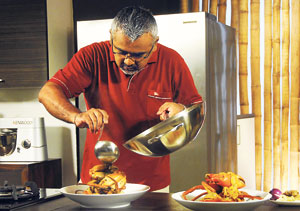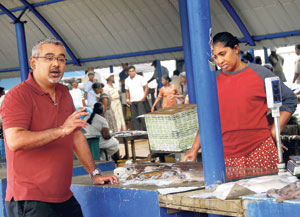The squid is so fresh that the patterns on its skin are still shifting. One can see the sea from the Negombo fish market and it’s one of the reasons Darshan Munidasa considers this one of the best places on the island to purchase seafood. A restaurateur and chef, Darshan is the name behind Nihonbashi, one of country’s finest Japanese restaurants.
But it’s in his capacity as a T.V personality that he’s in Negombo today. The market is to be the location for one of the last episodes of this season’s ‘Culinary Journeys with Darshan’.
The fresh squid that is purchased here will be transported back to Colombo, encased in several kilos of ice. The recipe that Darshan finally employs is sure to be simplicity itself, but it is part of his philosophy that his ingredients must be of the finest quality he can find – regardless of the effort it takes to procure them. If you like your fish canned, this might not be the show for you.
Part travelogue, part culinary class, Journeys showcases Darshan’s holistic approach to food. His mixed heritage (Japanese on his mother’s side and Sri Lankan on his father’s) gives him an enviable access to both cultures. So far, he’s taken viewers to Tokyo, where the bustling fish market yielded more than enough material for an action packed episode (including a shot of an irate vendor flinging water at the camera). He’s also been to Singapore in pursuit of the best chilli crab to be had. But of the 14 episodes that make up the first season, most have been shot in Sri Lanka in Darshan’s custom-designed kitchen in Rajagiriya.
Having driven back from Negombo, we make our way there in the afternoon to see the squid prepared. That’s when we discover that there are crabs on the menu instead. Having stopped at an exporter’s outlet on his way back, Darshan has bought two fine specimens, each worth approximately Rs.3, 500.
It’s a good example of how the show’s content remains a flexible thing, dependent on what Darshan finds in the market this week. The crabs weigh several kgs, one is male, the other female, says Darshan, pointing out how to see which one has more flesh (if the shell on the underside, near the upper claws is soft, chances are it has less flesh). A feast is prepared in minutes – the recipe is already up at “http://www.etv.lk” www.etv.lk – and seems to require barely any effort. After the production team is satisfied they’ve nailed it, they all dig in, savouring mouthfuls of tender crab meat.
Later, when we sit down for an interview, Darshan assures me that “all dishes are easy.” If you’ve seen the show, you know that he takes care to stay natural and unintimidating. When he cuts onions, it takes him a minute and his knife sometimes slips, quite in contrast to the slick professionals that rule some cookery shows. He makes no apologies for this.
Never having studied cookery, Darshan says that his greatest muse and critic has been his own appetite. As a result, his recipes seldom include any clear measurements – instead Darshan goes by instinct. “I never measure anything,” he says ruefully. “Sometimes I go by colour or by smell or feel.” He’d like his viewers to take a leaf from his book, tuning into their own inner chef instead of relying on a rigid recipe.
If anything, Darshan is educating people on the value of the right ingredients. “50% of your dish is the quality of your ingredients,” he says speaking of Japanese cuisine. He adds: “By default since you use the best possible ingredients you can find, you serve one ingredient at a time.” He’s learnt a lot from the vendors he befriends wherever he goes. (He’s known the exporter he buys the crabs from for 10 years). “We know each other by name. It’s very important. The heart of the show came from that,” he says, adding “I have to take back D.V.Ds of the show for him next time.”
When it comes to ingredients, Darshan can be so exacting that even the salt in his kitchens is carefully selected (he loves a particular locally manufactured brand so much, he’s been known to give it as a gift). He ascribes this attitude to a culture that gave rise to the intricate arts of bonsai and origami. “You need tunnel vision and dedication to one art,” he says, adding later, “if you want to show off what we have, we have to use the best of what we have.”
 |
Darshan is unabashedly patriotic, especially when it comes to Sri Lankan tuna and crabs. But he’s also very proud of his Japanese heritage. “I’ve always wanted to showcase Japan,” says Darshan, explaining that he hopes to film episodes of the second season there as well. “Japan has the highest number of food shows in the world,” he says, adding that Tokyo has more Michelin stars than London, Paris and New York combined. All this despite the fact that a lot of these hotels have menus that are virtually incomprehensible to many foreigners. Darshan sees his role here as an interpreter of cultures. “It takes someone who knows both countries,” he says.
Darshan shares all of this in between small sniffles. Despite what appears to be a flu, he’s at work planning menus among other things. Here, more than anywhere else, canny businessman meets culinary artist. “I work seven days a week,” he says, explaining that after 15 years of existence his restaurant Nihonbashi is still the gem in his crown. He makes personal appearances at the restaurant and frequently cooks for guests. The restaurant kitchen is the one he’s most comfortable in, but he’ll soon have a new kitchen installed for his second year of Journeys.
What has he learnt from the first? Looking back, Darshan says he and his production team have climbed a steep learning curve together. “It took me a month or two to understand what they were talking about,” he says ruefully. Darshan is his own most exacting viewer – pointing to his T.V, he says “each episode loops for four hours.” When they first began, Darshan was nervous, (he doesn’t like episode one much in retrospect) but he believes in the Toyota mantra of “continuous improvement.” “No matter how bad you are, you have to start somewhere and keep improving,” he declares.
Telling me that they filmed their final episode the day before, Darshan says he’s looking forward to the premiere of season 2 next year. They’ll have to pull in more sponsors to support the show, and Darshan himself will continue to do his work gratis. Still he’s not hesitant to give it all he’s got – “I’ve nothing to lose and everything to gain. This is an investment I’m making on myself,” he says.
Culinary Journeys with Darshan airs on Monday at 8 p.m. and on Sunday at 1 p.m.
and 7 p.m.
|




